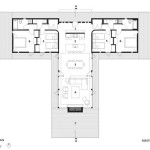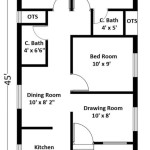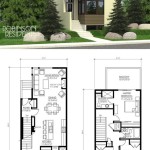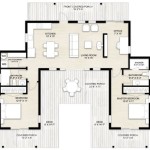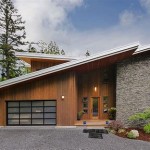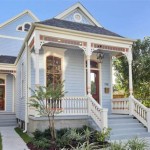Atrium style house plans are characterized by a central courtyard or atrium, around which the living spaces are arranged. Atriums provide natural light and ventilation to the interior of the house, and they can also be used as a social space or garden.
Atrium houses are a popular choice in warm climates, where they can take advantage of the natural breeze to cool the house. They are also a good option for people who want to live in a more open and airy space. However, atrium houses can be more expensive to build than traditional houses, and they may not be suitable for all climates.
In this article, we will discuss the advantages and disadvantages of atrium style house plans, and we will provide some tips for designing an atrium house.
Here are 8 important points about atrium style house plans:
- Open and airy
- Natural light and ventilation
- Social space or garden
- Popular in warm climates
- Can be expensive to build
- May not be suitable for all climates
- Customizable
- Energy-efficient
Atrium style house plans can be a great option for people who want to live in a more open and airy space. They are also a good choice for people who live in warm climates and want to take advantage of the natural breeze to cool their house. However, it is important to keep in mind that atrium houses can be more expensive to build than traditional houses, and they may not be suitable for all climates.
Open and airy
One of the main advantages of atrium style house plans is that they are open and airy. The central atrium allows for natural light and ventilation to flow throughout the house, creating a bright and spacious living environment.
- High ceilings: Atrium houses often have high ceilings, which can make the space feel even more open and airy. High ceilings also allow for more natural light to enter the house.
- Large windows: Atrium houses typically have large windows that overlook the atrium. These windows allow for plenty of natural light to enter the house, and they also provide views of the outdoors.
- Open floor plans: Atrium houses often have open floor plans, which means that the living spaces are not separated by walls. This creates a more open and airy feeling, and it also makes it easier to move around the house.
- Natural ventilation: The atrium can act as a natural ventilation system for the house. When the windows are open, the breeze can flow through the atrium and into the living spaces. This can help to keep the house cool and comfortable, even on hot days.
Overall, atrium style house plans are a good choice for people who want to live in a more open and airy space. The central atrium allows for natural light and ventilation to flow throughout the house, creating a bright and spacious living environment.
Natural light and ventilation
One of the main advantages of atrium style house plans is that they allow for natural light and ventilation to flow throughout the house. The central atrium acts as a natural light well, bringing sunlight into the interior of the house. The atrium also allows for natural ventilation, as the breeze can flow through the atrium and into the living spaces.
Here are some of the benefits of natural light and ventilation in atrium style house plans:
- Improved indoor air quality: Natural ventilation helps to improve indoor air quality by removing pollutants and stale air. This can help to reduce the risk of respiratory problems, such as asthma and allergies.
- Reduced energy costs: Natural light and ventilation can help to reduce energy costs by reducing the need for artificial lighting and air conditioning.
- Increased comfort: Natural light and ventilation can help to create a more comfortable living environment. Natural light has been shown to improve mood and productivity, and it can also help to reduce stress.
Overall, natural light and ventilation are important considerations for any home, but they are especially important for atrium style house plans. The central atrium allows for natural light and ventilation to flow throughout the house, creating a bright, airy, and comfortable living environment.
Here are some tips for designing an atrium house to maximize natural light and ventilation:
- Orient the atrium to the south: This will allow for maximum sunlight to enter the atrium throughout the day.
- Use large windows: Large windows will allow for more natural light to enter the atrium and the living spaces.
- Use skylights: Skylights can be used to bring natural light into the atrium from above.
- Install operable windows: Operable windows will allow you to control the flow of natural ventilation through the atrium.
By following these tips, you can design an atrium house that is filled with natural light and fresh air.
Social space or garden
The central atrium in an atrium style house plan can be used as a social space or garden. This is a great place to entertain guests, relax with family, or simply enjoy the outdoors. Here are some of the benefits of using the atrium as a social space or garden:
- Extended living space: The atrium can be used as an extension of the living space, providing additional space for entertaining or relaxing.
- Outdoor oasis: The atrium can be transformed into an outdoor oasis, complete with plants, flowers, and a water feature.
- Natural light and ventilation: The atrium provides natural light and ventilation, creating a bright and airy space.
- Privacy: The atrium is surrounded by the house, providing privacy from the outside world.
Here are some tips for designing an atrium that can be used as a social space or garden:
- Choose the right size: The atrium should be large enough to accommodate your needs, but not so large that it feels overwhelming.
- Plan for furniture: If you plan to use the atrium as a social space, be sure to choose furniture that is comfortable and weather-resistant.
- Add plants: Plants can help to create a more inviting and relaxing space. Choose plants that are tolerant of the climate in your area.
- Consider a water feature: A water feature can add a touch of tranquility to the atrium. Choose a water feature that is appropriate for the size of your atrium.
By following these tips, you can design an atrium that is a beautiful and functional social space or garden.
Popular in warm climates
Atrium style house plans are popular in warm climates because they provide natural light and ventilation, which can help to keep the house cool and comfortable. The central atrium acts as a natural heat sink, absorbing heat from the sun during the day and releasing it at night. This helps to regulate the temperature of the house, reducing the need for air conditioning.
In addition, the atrium can be used to create a cross-breeze, which can help to circulate air throughout the house and keep it cool. This is especially beneficial in hot and humid climates.
Here are some of the benefits of atrium style house plans in warm climates:
- Reduced energy costs: Atrium style house plans can help to reduce energy costs by reducing the need for air conditioning.
- Increased comfort: Atrium style house plans can help to create a more comfortable living environment by providing natural light and ventilation.
- Improved indoor air quality: Atrium style house plans can help to improve indoor air quality by removing pollutants and stale air.
- Extended living space: The atrium can be used as an extension of the living space, providing additional space for entertaining or relaxing.
Overall, atrium style house plans are a good choice for people who live in warm climates. They provide natural light and ventilation, which can help to keep the house cool and comfortable, and they can also help to reduce energy costs.
Here are some tips for designing an atrium house for a warm climate:
- Orient the atrium to the south: This will allow for maximum sunlight to enter the atrium throughout the day.
- Use large windows: Large windows will allow for more natural light to enter the atrium and the living spaces.
- Use skylights: Skylights can be used to bring natural light into the atrium from above.
- Install operable windows: Operable windows will allow you to control the flow of natural ventilation through the atrium.
- Consider using fans: Fans can help to circulate air throughout the atrium and the living spaces.
By following these tips, you can design an atrium house that is cool and comfortable, even in the warmest climates.
Can be expensive to build
Atrium style house plans can be expensive to build due to the following factors:
- Materials: Atrium houses require more materials than traditional houses, including glass, steel, and concrete. These materials can be expensive, especially in large quantities.
- Labor: Atrium houses require specialized labor to build, as the construction process is more complex than that of a traditional house. This can increase the cost of labor.
- Engineering: Atrium houses require careful engineering to ensure that the structure is sound and can withstand the elements. This can add to the cost of the house.
- Permits: Atrium houses may require special permits from the local building department. These permits can be expensive, and they can also delay the construction process.
Overall, atrium style house plans can be expensive to build. However, the benefits of an atrium house, such as the natural light, ventilation, and open space, may outweigh the costs for some people.
May not be suitable for all climates
Atrium style house plans may not be suitable for all climates. Here are some of the challenges that can arise when building an atrium house in a cold climate:
- Heat loss: Atrium houses can lose heat more easily than traditional houses due to the large amount of glass and the high ceilings. This can make it difficult to keep the house warm in cold weather, which can lead to high energy costs.
- Condensation: The high humidity levels in an atrium house can lead to condensation on the windows and walls. This can create a moisture problem, which can damage the house and lead to mold growth.
- Snow and ice: Snow and ice can accumulate on the atrium roof and windows, which can block the sunlight and make it difficult to enter and exit the house. This can be a safety hazard, especially in areas with heavy snowfall.
- Maintenance: Atrium houses require more maintenance than traditional houses. The glass and steel components of the atrium need to be cleaned and inspected regularly to prevent damage.
Overall, atrium style house plans are best suited for warm climates. However, with careful planning and design, it is possible to build an atrium house in a cold climate. It is important to consult with a qualified architect or builder to ensure that the house is properly designed and constructed to withstand the local climate.
Customizable
One of the great things about atrium style house plans is that they are highly customizable. You can choose the size, shape, and style of your atrium, as well as the materials used to build it. This allows you to create a home that is truly unique and reflects your personal style.
Here are some of the ways you can customize your atrium style house plan:
- Size and shape: Atriums can be any size or shape, from small and intimate to large and grand. You can choose the size and shape that best suits your needs and the size of your property.
- Style: Atriums can be designed in a variety of styles, from traditional to contemporary. You can choose a style that matches the overall style of your home, or you can create a unique and eclectic look.
- Materials: Atriums can be built using a variety of materials, including glass, steel, wood, and concrete. You can choose the materials that best suit your budget and your aesthetic preferences.
In addition to the above, you can also customize your atrium style house plan by adding features such as balconies, mezzanines, and skylights. You can also choose to have your atrium open to the elements or enclosed with glass. The possibilities are endless.
If you are considering building an atrium style house, be sure to work with an experienced architect or builder who can help you create a home that is both beautiful and functional.
Energy-efficient
Atrium style house plans can be very energy-efficient, as they can take advantage of natural light and ventilation to reduce the need for artificial lighting and air conditioning. Here are some of the ways that atrium style house plans can be energy-efficient:
Passive solar design: Atriums can be designed to take advantage of passive solar design principles. This means that the atrium is oriented to the south and has large windows to allow sunlight to enter the house during the winter months. The sunlight is absorbed by the thermal mass of the house, such as the concrete floor and walls, and is released at night when the temperature drops. This helps to keep the house warm in the winter without the need for additional heating.
Natural ventilation: Atriums can also be used to promote natural ventilation. When the windows in the atrium are open, the breeze can flow through the atrium and into the living spaces. This helps to cool the house in the summer without the need for air conditioning.
Energy-efficient materials: Atrium style house plans can be built using energy-efficient materials, such as low-e windows and insulated concrete forms (ICFs). These materials help to reduce heat loss and gain, which can save energy and money on heating and cooling costs.
Overall, atrium style house plans can be very energy-efficient. By taking advantage of natural light and ventilation, and by using energy-efficient materials, you can design a home that is comfortable and affordable to operate.










Related Posts


